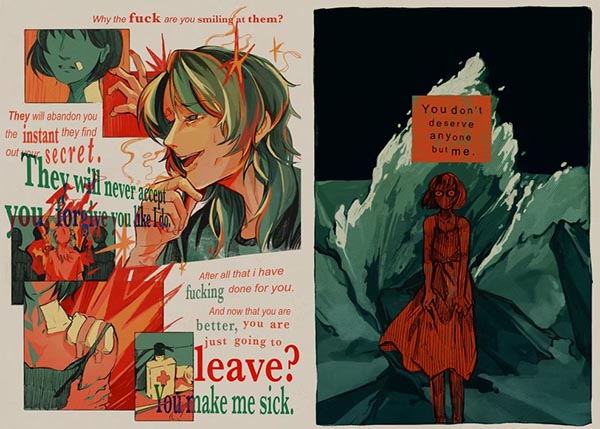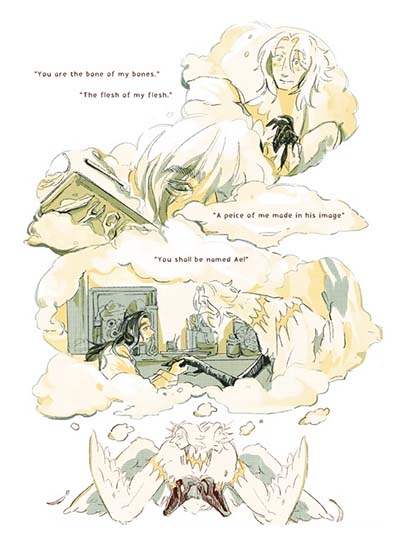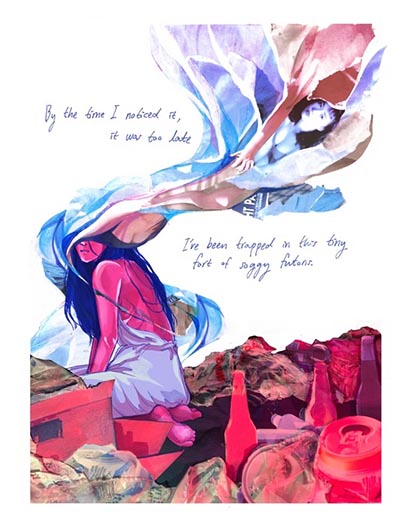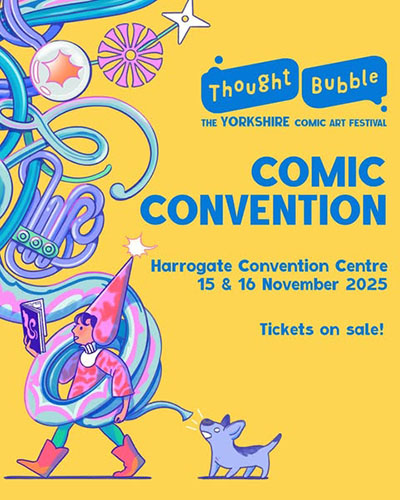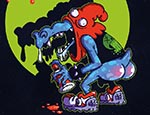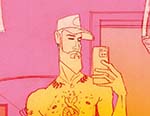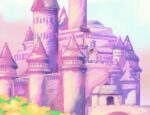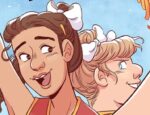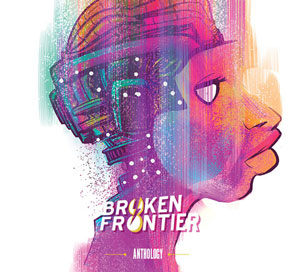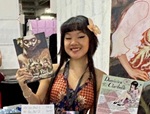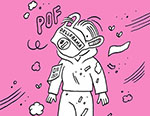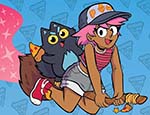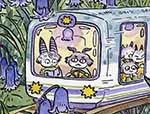THOUGHT BUBBLE MONTH 2025! When I discovered the work of self-published comics artist Rein Lee at the inQ! queer comics fair last year I pretty much instantly knew that they were going to be on our Broken Frontier ‘Six Small Press Creators to Watch‘ list for 2025. Rein’s work is hauntingly gorgeous in composition and constantly experimental in presentation, whether that be in format or layout. Their comics have included the flipbook format Tidal Waves telling a story about a toxic relationship from two perspectives, and My Taxidermy Angel, exploring themes of queerness and identity in metaphorical terms.
As part of this year’s ‘Six to Watch’ spotlight interviews, and ahead of their Thought Bubble appearance, I caught up with Rein to chat about experimenting with the medium, creative process, and finding your feet in the comics community as a newcomer…
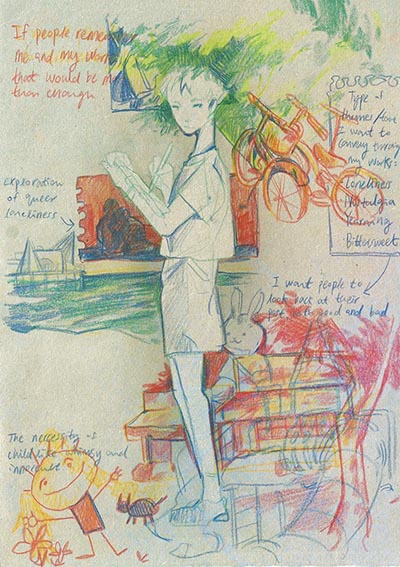
ANDY OLIVER: Let’s start with the obvious ‘Six to Watch’ introductory question, Rein. Tell us about yourself and your wider artistic background?
REIN LEE: Hi! My name is Rein Lee, I am a London-based artist that just graduated last year. My major was in Illustration and Animation but I started dabbling in comics in my final year. Right now, I am a self-published comic artist and freelance illustrator, juggling several part-time jobs whilst trying to find my footing in the comic world.
AO: What was your route into discovering comics and what is it about the form that appeals to you as a storytelling medium?
LEE: I grew up with manga and manhwa as a kid when I was living in Korea, so I was familiar with visual narratives made in east Asia. I got to learn more about the UK indie comic scene better when I moved to the UK and started visiting art fairs during school holidays. I specifically remember the first time I visited London Comic Con and the South London Comic and Zine Fair, chatting with artists behind the stall and being introduced to new work; that really inspired me to make comics. I loved how these indie creators experimented with what comics can be to create work that was fresh and exciting; it really opened my eyes that comics don’t all have to be black and white, polished, serialised work.
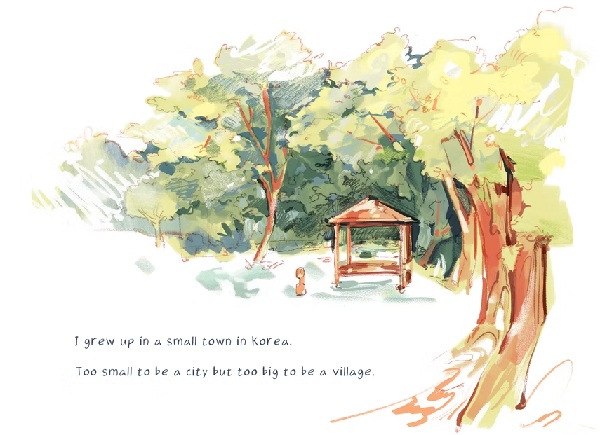
I think comics appeal to me as a storytelling medium due to its flexibility and accessibility. There are new comics being created every day that push the boundaries of what a comic ought to be, whether that is its physical format, panels, narrative, dialogue and visual style; and for me that excites me the most about making my own comics. I also think for some stories art can be a better method to tell a narrative rather than text and be more inviting to younger audiences or those with difficulties reading. I specifically remember struggling to read in English when I first moved countries, and comics have greatly helped me to build my confidence in reading and writing. I’m also happy that more and more people are making zines and short comics, I think it is a really inviting and accessible medium.
AO: We’ll speak about specific projects in a moment but what are the kind of themes you look to explore in your self-published comics?
LEE: I think themes around human connection and loneliness are a constant throughline in all of my works. Connecting and caring for people, and searching for companionship is hard, especially if you are already carrying a lot of baggage on your own. And unfortunately sometimes people that you care for won’t be able to be there for you the way you wished to be, not out of malice or hate but simply because they are human. I think that’s why a lot of my comics are about learning how to understand and connect with others that have fundamentally different ways of viewing the world. Extending empathy and kindness to others is the first step in being kinder to yourself, or at the very least that’s what helped me.
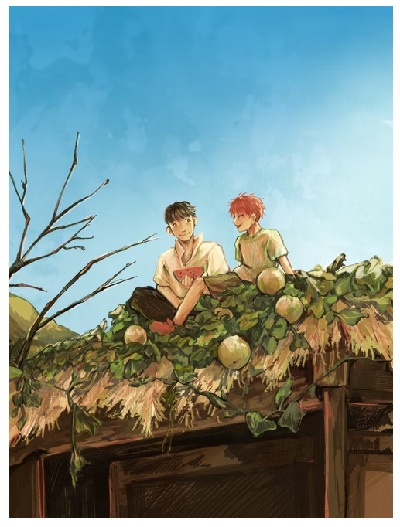
I think queerness is also a throughline in my work that naturally seeps into my work. It is hard to make it not part of my work considering it is a big aspect of my identity and experience. I also think it goes nicely hand in hand with human connections as a theme; especially considering the current climate it makes the initial message more powerful.
AO: At this point I imagine Tidal Waves will be the one comic people are most likely to have seen from your published output. Can you describe the very tactile approach to that story and why you chose such a clever use of the physicality of the comic as an object to reflect its narrative approach?
LEE: I think I made Tidal Waves around the time I was actively looking into more unconventional layouts of books and comics. I liked the idea of a book that required the reader to fiddle around, twist, pull and turn them around to properly experience it. It made the story that much more engaging and like you were an active participant in the story. I found the half way, upside down book format to work the best for the narrative I had in mind where two characters were in conflict due to their differing experience and thought process. Often we get caught up in our own narratives and internal thought processes to view the other perspective. We all have our reasonings for saying and doing the things we do, no matter how heinous or unjustifiable they may be.
In the comic, the two characters are both horrible and bring out the worst in each other. They are both unreliable narrators, telling a story drenched in biases, excuses and hurt. I wanted the reader to not focus on deciding which one of the characters is worse (although I have my own opinions on that front), but to look at how they influenced each other and the cycle they are stuck in due to that. I wanted the format to give each side equal weight, so that you could always go back, turn around and read again, it never really ends until you put the book down.
AO: One of the elements of your practice that really draws me to your work is a constant sense of experimentation with the pure language of comics. That’s very evident for example in the inventive page layouts of My Taxidermy Angel which I described as an “allegory about queerness, identity and self-acceptance” when I reviewed it at BF, or in the non-conventional page layouts of your minicomic Sour Grapes. Are you consciously constantly looking to experiment with the form’s possibilities? Or is it more a case of finding your own voice at this point?
LEE: I am glad you noticed! Experimental page layouts and visual storytelling is what drew me into comics in the first place so I try to be extra conscious in how I lay out my visuals. I find a lot of inspiration in poetry comics and children’s book illustrations when panelling, and I want every page and image to matter. When storyboarding, often I would have a number of visuals and dialogues I want to include in a given scene set out planned and just play around with how I could lay them out, creating multiple thumbnails of the same scene. Sour Grapes was actually part of an animation project I did during sixth form that I wanted to re-create through the format of zines. I printed out the images and assets used for that project, collaged and rearranged them to tell a different story. It was fun revisiting and repurposing old art like that, and I hope to continue to do them in the future!
AO: Your art is so stunning in composition and use of colour. Can you tell us about your creative process? What mediums do you work in?
LEE: I usually use Procreate and digital art for ease, but I try to incorporate scanned textures and assets to give it a more tactile feel. Watercolour and colour pencils used to be my main medium for a long time, and although I don’t think I have the patience to dedicate an entire comic using those mediums, I try to replicate them in the best ways I can. In terms of colour schemes I try to test out at least 5 different types of colour pallets on a series of pages before deciding which one looks the best. I also love when comic artists switch colour schemes depending on the central character/theme so I try to do that in my works as well.
AO: As someone newer to the small press scene what advice would you give to people thinking about self-publishing for the first time? What have been some of the most valuable lessons you have learnt to date?
LEE: It may sound corny and cliché but just get your work out there! I graduated last year, and I have been selling my work for about two years now. I’ve had so much anxiety around putting my work out there, contacting artists and bookshops, answering to open calls and pitches. Not every attempt was successful and not everyone liked what I made but the few that did have opened up so many avenues and resources for me. There are people out there that are interested in what you produce and what you have to say, and it is all about that leap of faith. I am still trying to find my footing in the wider comic industry, and I am so grateful to have met this community of self-published artists that has been so welcoming and helpful. So if you have things to say, post them on social media, print them out, apply to your local arts and crafts fair, contact indie comic shops! It can be anything and everything but it will eventually pay off.
AO: When we announced you as one of this year’s Six to Watch creators you spoke of possible future projects. So let’s finish up by asking what’s next for Rein Lee? What can we expect from you in 2026?
LEE: I have been working on Transmitting me and you a new 64-paged self-contained comic for several months now. The story follows Anh and Mara, two sentient creatures on a quest to find humans in a desolate world. With only an old vespa and a staticky radio as their guide, they make their way to a foreign radio tower on the horizon, where they will find buried truths and unexpected connections. It is another character-focused story that explores loneliness and grief, but overall hopeful and bittersweet in tone. I took on this project partially to improve drawing urban environments and paid a lot of attention in the settings of the story. I cannot say for sure when I will be able to finish it, but if you are interested in getting any further updates, I regularly post my process work on Instagram and Bluesky.
Interview by Andy Oliver
Visit Rein Lee’s site and store here
Rein Lee will be at Table B27a in the Comixology Hall at Thought Bubble.
Thought Bubble 2025 runs from November 1oth-16th with the convention weekend taking place on the 15th-16th. More details on the Thought Bubble site here.
Read all our Thought Bubble 2025 coverage so far in one place here.
Poster by Ng Yin Shian





